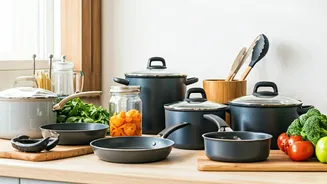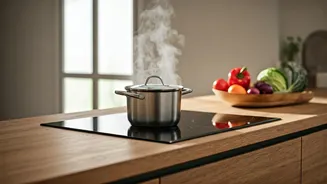Why Toxin-Free Matters
The shift towards conscious kitchens highlights the significant impact our cookware and appliances have on our well-being. Traditional cooking tools often
contain potentially harmful chemicals that can leach into food during cooking, especially at high temperatures. These chemicals, such as PFOA and PTFE found in some non-stick surfaces, have been linked to various health concerns, including hormonal disruption and even certain cancers. Additionally, certain materials like aluminum, when used in cookware, can pose risks. In contrast, choosing toxin-free alternatives minimizes exposure to these potentially hazardous substances, thereby contributing to a safer and healthier culinary environment. This growing awareness is driving consumers to seek out materials that prioritize health and safety. Furthermore, the longevity and durability of toxin-free options often make them a sound investment, reducing the need for frequent replacements and promoting sustainability in the kitchen. As a result, prioritizing toxin-free cookware becomes a proactive step towards a more health-conscious lifestyle.
The Design Factor
When considering the design of kitchenware, several factors contribute to a conscious approach. The materials used play a crucial role. Opting for stainless steel, cast iron, ceramic, glass, and wood-based items reduces the risk of chemical leaching and ensures that the materials are heat resistant and durable. The design should also consider functionality and ease of use. Ergonomic handles, well-fitting lids, and even heat distribution are essential for an effective and enjoyable cooking experience. The construction of the cookware influences its safety. Items with secure joints and non-reactive surfaces prevent contamination. This encompasses how the cookware is assembled and how it interacts with food during the cooking process. Another facet of design is the aesthetics. A well-designed kitchen not only functions effectively but also fosters a sense of well-being. Furthermore, the design of appliances like induction cooktops contributes to a safer environment by minimizing heat exposure. The design choices should thus incorporate both functionality and health-consciousness for a more conscious approach to kitchen design.
Conscious Appliance Choices
The choices made in selecting appliances significantly impact the health and sustainability of a conscious kitchen. Opting for energy-efficient models can lower the carbon footprint and reduce energy bills. Stainless steel refrigerators, induction cooktops, and slow cookers made from safe materials are excellent choices. Another crucial aspect is to assess the materials used in appliance construction. Look for options that are free of harmful chemicals. For example, some blenders and food processors use plastics that can leach chemicals. Prioritizing glass or stainless steel containers over plastic is a simple step towards a healthier cooking environment. Moreover, consciously choosing appliances also supports ethical manufacturing practices. Selecting brands that prioritize fair labor standards and sustainable sourcing contributes to a more responsible and mindful kitchen. Consider features such as air fryers with non-toxic coatings or electric kettles made of glass or stainless steel. Such choices improve the safety of the kitchen. Regularly maintaining and cleaning the appliances, along with proper storage practices, prolong their lifespan and reduce the need for replacements.
Making the Switch
Transitioning to a conscious kitchen can be a gradual and rewarding journey. The first step involves assessing the existing cookware and appliances. Identify items that contain potentially harmful materials like those with non-stick coatings containing chemicals. Replace these items with safer alternatives made from stainless steel, cast iron, ceramic, or glass. Research and compare different brands, paying attention to certifications and material information. Look for labels that indicate the products are free of harmful chemicals. Another approach is to begin with the most frequently used items, and gradually replace them as needed. This approach avoids a complete overhaul and can be more budget-friendly. Educating oneself about the health risks associated with various materials and the importance of choosing non-toxic options can help maintain the commitment. Exploring various recipes and cooking methods that accommodate the new cookware can also inspire creativity in the kitchen. The ultimate aim is to create a space that promotes health, safety, and a mindful approach to food preparation.












